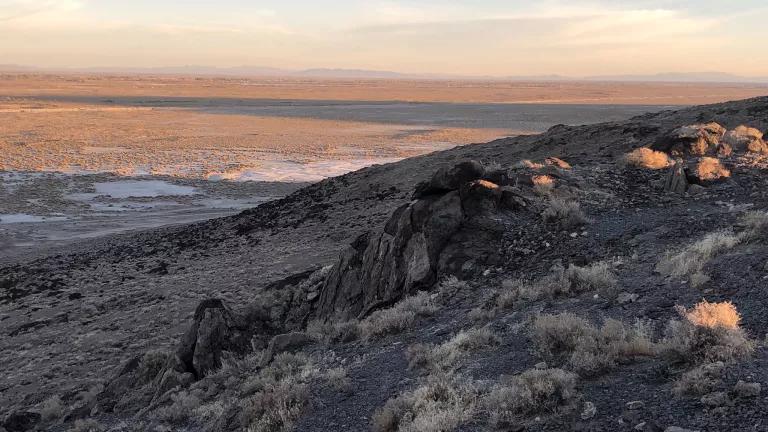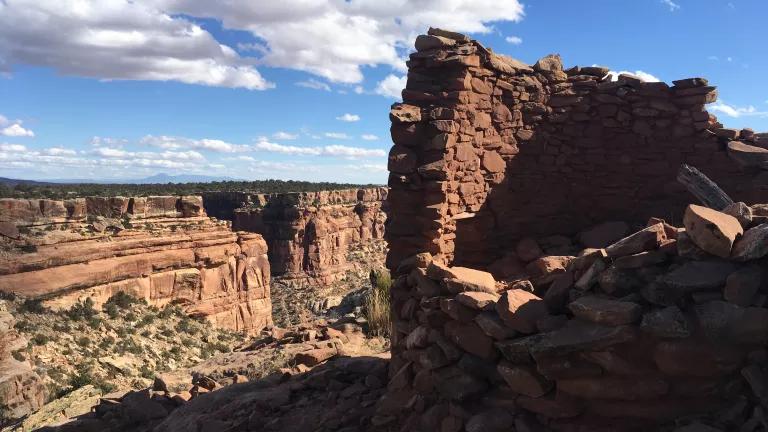Defense Bill Compromise for Northern Nevada Lands and Tribes
This year's annual defense bill contained an expansion of the Fallon Naval Air Station in northern Nevada—a compromise that strives to resolve complex land use issues and protect the environment.

BLM lands in Grimes Archeological Area, overlooking the Numu Newe Special Management Area, Northern Nevada
Among many things, Nevada is known for its seemingly never-ending, expansive topography, home to an extraordinary wealth of biodiversity and profound cultural significance. In fact, more than 80 percent of Nevada’s lands are managed by the federal government, the highest percentage in the United States. The vast majority of that land is overseen by the Bureau of Land Management, which has the complicated job of trying to preserve cultural and ecological resources while also managing a number of impactful permitted activities such as mining and livestock grazing.
Making the bureau’s job even more complicated, much of Nevada’s federal land has historically been withdrawn from public use to support Department of Energy (DOE) and Department of Defense (DOD) activities and operations. In particular, the state’s desert lands have been utilized extensively by the DOD to support key national security objectives.
The bureau’s challenge of maintaining some semblance of sustainability only increased due to a U.S. Navy proposal to substantially expand training and live fire operations on federal and tribal lands in northern Nevada. Due to evolving training needs, the U.S. Navy proposed to considerably expand its operations in connection with the Fallon Naval Air Station, home to the Navy Strike Fighter Tactics Instructor program, more commonly and colloquially known as “Top Gun.” The proposal would have added more than 600,000 acres to the existing 200,000 acres of federal lands already being utilized by the military at the Fallon training complex.
The Fallon region is a prime example of a high desert landscape, the type of environment Nevada is particularly known for and one that is home to delicate ecosystems and unique wildlife. In addition, multiple Indigenous nations have lived on these lands for millennia. But due to ongoing defense activities, the Fallon Paiute Shoshone and Walker River Tribes’ ancestral and aboriginal lands have been directly impacted by U.S. Navy and other DOD training operations at Fallon, limiting tribal access to sacred sites, damaging cultural areas, and degrading the tribes’ quality of life. Absent critical safeguards, the original expansion proposal would have greatly exacerbated these conditions.
Given the juxtaposition between increased degradation of public and tribal resources versus the navy’s need to expand operations in terms of military readiness, the past five years have been punctuated by a series of discussions and negotiations about whether a viable compromise could be brokered among many of the key stakeholders. Such a compromise would need to be included in the National Defense Authorization Act (NDAA) for Fiscal Year 2023 (FY2023), an annual “must pass” bill that is critical in guiding DOD activities and operations for the upcoming calendar year. Thankfully, the FY2023 NDAA does indeed include language that strives to resolve these complex issues. As such, the DOD, and congressional NDAA negotiators needed to strike an incredibly sensitive balance that met the expanding training and national security needs of the U.S. Navy without adversely impacting the surrounding environment and tribes.

BLM lands in Grimes Archeological Area, overlooking the Numu Newe Special Management Area, Northern Nevada
The final expansion agreement in the FY2023 NDAA incorporates direct input from the tribes that was carried by Nevada’s congressional members, in particular Senators Catherine Cortez Masto (D-NV) and Jacky Rosen (D-NV), along with Representative Mark Amodei (NV-02). The language was also supported by the U.S. Navy and Department of the Interior. While the U.S. Navy receives much of the expansion it sought—558,535 acres in total—the integrated resource management plans of those lands must provide access to tribes and give them meaningful opportunities to comment on their development. The U.S. Navy will also conduct a survey to evaluate and inventory the culturally significant resources and sites with the goal of mitigating further harm to those areas.
The agreement also designates nearly 218,000 acres to create the Numu Newe Special Management Area that will protect the impacted environment and, to the maximum extent possible, preserve culturally and religiously significant tribal sites while similarly ensuring that tribes have critical access to their lands. Both the Fallon Paiute Shoshone and Walker River Tribes were also granted protected lands that are held in trust for their use and will be managed cooperatively with the tribes and Department of the Interior. The tribal nations will also receive funding to equitably address environmental justice concerns and to help integrate the tribes’ knowledge and expertise.
NRDC supported the Fallon Paiute Shoshone Tribe’s request to use part of the funding to establish the Numu Newe Cultural Center, which will support sustained tribal knowledge, culture, and language, and an identity that is tied so intricately to the land and the tribe’s way of life. NRDC is also thankful that all of the principals involved in the NDAA negotiation—including Interior Department staff, congressional members, and U.S. Navy leadership—were willing to incorporate input from the diverse array of interests, which aligned behind the deep-seated conviction that conservation of this critical area and the ongoing need to meet core military training and readiness needs were not inherently incompatible. This agreement is the outcome of years of negotiations between the U.S. Navy, Congress, the affected counties in Nevada, and local tribes, and it reflects the very notion that protecting the environment and protecting national security are not mutually exclusive.





